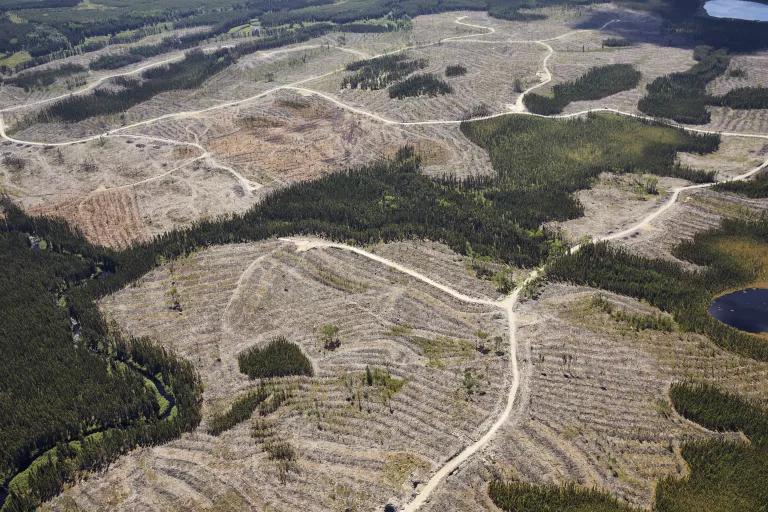Evidence Mounts in P&G’s Role in Degrading Intact Forests
A new NRDC analysis of Canadian logging companies supplying boreal pulp to the U.S. marketplace is showing just how toilet paper-thin Procter & Gamble’s (P&G) latest claims of sustainability are.
A new NRDC analysis of Canadian logging companies supplying boreal pulp to the U.S. marketplace is showing just how toilet paper-thin Procter & Gamble’s (P&G) latest claims of sustainability are. By a Thousand Cuts: How Powerful Companies’ Wood Sourcing is Degrading Canada’s Boreal Forest casts light on how mills in Ontario and Quebec that supply pulp to companies like P&G are failing to ensure that their forest sourcing does not come at the cost of fundamental Indigenous rights, threatened species, and the global climate.
In its new analysis, NRDC reviews wood sourcing from public forest units in Ontario and Quebec for mill operations owned by Aditya Birla Group, Domtar, and Resolute Forest Products (summarized in NRDC’s blog here), and found that these three companies’ wood sourcing threatens species’ habitat and is conducted without protocols in place to require the protection of Indigenous rights.
In the context of mill sourcing by the three companies, NRDC’s report estimates that logging in forest units containing majority boreal caribou habitat is overwhelmingly conducted under weak forest certification schemes rather than under the more rigorous Forest Stewardship Council (FSC) certification (see Table 3 of the report below). Because these areas lack FSC certification, there are virtually no science-based protections in place to require the protection of large areas of boreal caribou habitat, which would give the species a fighting chance at survival.

In forest units supplying the companies’ mills that are at least 50% boreal caribou habitat, nine times more wood volume came from non-FSC-certified areas than from areas that have FSC certification.
NRDC
And while P&G has a stated preference for pulp from FSC-certified forests, and recently released a Charmin advertisement touting that the brand protects forests by using FSC-certified pulp, the company continues to source from these pulp producers, all of whom are sourcing from forest units with threatened species habitat without the stronger protections that FSC requires. What’s worse, in its new “Wood Pulp Sourcing Policy” P&G characterizes weak forest certification systems as sustainable, thereby permitting its suppliers to exploit these standards in areas where protections for threatened species like boreal caribou are essential.
The report further finds that these three suppliers do not require wood they purchase to have been logged with the free, prior, and informed consent (FPIC) of Indigenous Peoples whose traditional territories are impacted by these forestry operations. While P&G’s latest pulp sourcing policy announces the company’s support for FPIC, the policy lacks an affirmative commitment to ensuring its suppliers adhere to this critical practice or transparent processes for how the company will address issues of noncompliance or provide clear consequences for violators in its supply chain.
P&G’s climate commitments are similarly shown to be mere window dressing in light of this new report’s findings. While P&G has made an unambitious commitment to net zero carbon emissions for scope 1 and 2 emissions by 2030, the company has yet to make a clear, time-bound commitment to reduce its upstream scope 3 emissions. This is all the more problematic because the threatened boreal caribou habitat that overlaps with many forest units is also intact, carbon-dense forest, the loss of which is unleashing vast stores of carbon into the atmosphere and undermining some of the world’s greatest natural climate allies.

Roads and clearcuts across the boreal forest
Given the urgency of addressing the dual climate and biodiversity crises, it’s essential that P&G make substantive commitments to publicly report on and reduce its impact on forests - both for the communities and species that rely on these ecosystems, as well as to address the associated risks posed to P&G’s shareholder investments. As a starting point, these should include: requiring suppliers to prove their compliance with FPIC; avoiding primary/intact forests in its supply chains; ceasing its characterization of weak certification systems as responsible; and accounting for and reporting its progress on reducing its scope 3 emissions, particularly in relation to its forest carbon footprint. Above all, to reduce pressure on threatened forests like Canada’s boreal, P&G and other manufacturers of throwaway tissue products must cease relying entirely on virgin forest pulp for these products and instead incorporate more sustainable alternatives, including recycled content.
Investors delivered a clear, and overwhelming, directive to P&G last October telling the company it must address its deforestation and intact forest degradation risk exposure. But P&G’s latest announcement for shareholders favors lofty language over concrete commitments to ceasing intact forest degradation in one of the world’s most important carbon storehouses.
As mounting evidence on the ground reveals practices that threaten communities’ rights, species protections, and the global climate, what actions will P&G take to address the risks its wood pulp supply chain poses? It’s clear that solutions exist, but global environmental crises, as well as the company’s own reputation and future, can’t afford to wait for P&G to act.





